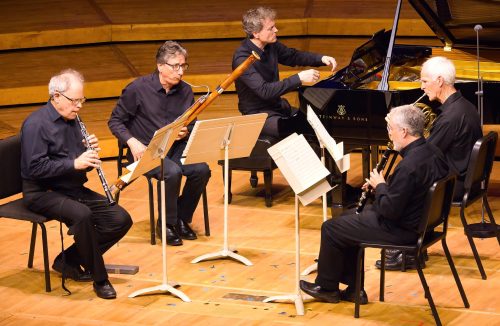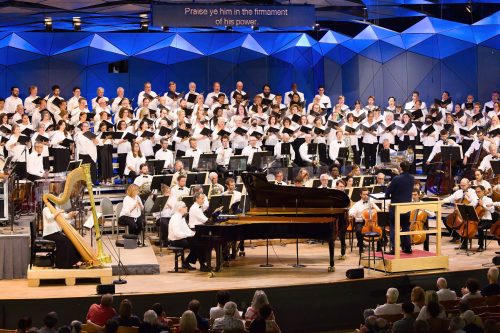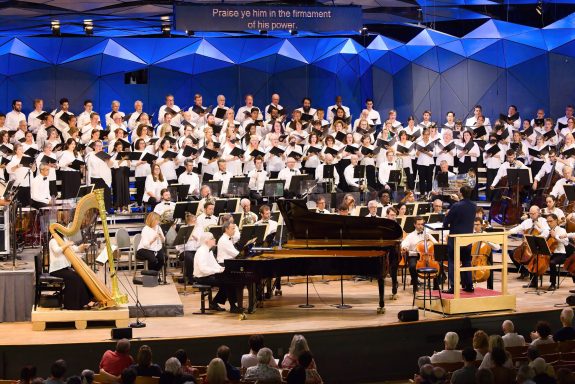 United States Tanglewood Festival 2024 [7]: (CSa)
United States Tanglewood Festival 2024 [7]: (CSa)

24.7.2024 – Boston Symphony Chamber Players: Haldan Martinson (violin), Steven Ansell (viola), Blaise Déjardin (cello), Edwin Barker (double-bass), Elizabeth Rowe (flute), John Ferrillo (oboe), William R. Hudgins (clarinet), Richard Svoboda (bassoon), Richard Sebring (horn) with Paul Lewis (piano), and BSO members: Alexander Velinzon and Tatiana Dimitriades (violins), Cathy Basrak and Daniel Kim (violas), Blaise Déjardin and Oliver Aldort (cellos). Seiji Ozawa Hall, Lenox.
Alison Loggins-Hull – Homeland for solo flute
Mozart – Quintet in E-flat for piano and winds, K.452
Brahms – String Sextet No.2 in G, Op.36
Following his spectacular series of Beethoven piano concertos with the Boston Symphony Orchestra and Andris Nelsons at Tanglewood in 2022, British pianist Paul Lewis made a welcome return last week for two outstanding events: a chamber recital in which he joined members of the Boston Symphony Chamber Players in an intimate and finely balanced performance pf Mozart’s Quintet in E-flat for piano and winds, K.452, and a full blooded Sunday afternoon concert featuring Aaron Copland’s rarely heard Concerto for Piano and Orchestra.
Writing to his father in March 1784, Mozart declared that he considered his Quintet in E-flat for piano and winds, ‘the best work I have ever written’ and informed him that an audience of over 130 could be expected to attend its first performance in Vienna’s Burgtheater. The 28-year-old Wolfgang would doubtless have been thrilled that, 240 years later, on a sultry summer’s night in Lenox, Massachusetts, almost all of Ozawa Hall’s 1,200 seats would be filled, with many hundreds more spread out on lawns behind to hear Paul Lewis and four Boston Symphony wind partners reprise this miniature masterpiece. It is important to stress the element of partnership in this Tanglewood performance. Lewis has previously commented on how much less confrontational the relationship is between piano and the other instruments and his measured, fine-grained pianism never fought for preferential treatment. He remained a team player throughout, a partner in a conversation between equals. Divided into three movements, the opening Largo resonated sumptuously throughout the auditorium and contrasted vividly with a sprightly Allegro moderato. The tempo of the luxuriant Larghetto was perfectly judged with some fine unhurried interplay from the agile winds, followed by a beautifully balanced and crisp third movement Rondo and Allegro. Here was ensemble playing at its finest.
The Mozart Quintet was preceded by Alison Loggins-Hull’s Homeland for solo flute played with ethereal beauty by the BSO’s soon-to-retire principal flautist Elizabeth Rowe. The composer describes how Homeland was written shortly after Hurricane Maria stormed through Puerto Rico in 2017, and how she used this deadly meteorological event as a musical metaphor not only for the stark realities of climate change, but also for political and social unrest in the United States and beyond. The opening bars of Homeland, a series of timbral trills which conjure the image of troubled waters, were followed by dark fretful passages suggestive of the enormity of the problems facing us all for which there are no ready practical solutions. In the absence of answers, there is always the spiritual consolation of music.
This came after the interval in the form of Brahms’s richly autumnal String Sextet No.2 in G. Written in 1866, it reflected his tumultuous but ultimately doomed love affair with Agathe von Siebold to whom he was briefly engaged. From the outset, the six string players – formed from the ranks of the BSO – demonstrated their mastery of the work’s considerable technical demands. They carried off the complex counterpoint of the lovely opening Allegro with panache, while capturing the melancholy and light-hearted playfulness of the succeeding Scherzo. An achingly sad Adagio was dispelled by a gently paced and wonderfully sunny account of the closing movement which concluded in a mighty fugue.
28.7.2024 – Boston Symphony Orchestra / Andris Nelsons (conductor), Thomas Warfield (narrator), Paul Lewis (piano) Tanglewood Festival Chorus / James Burton (conductor). Koussevitzky Shed, Lenox.
James Lee III – Freedom’s Genuine Dawn, for narrator and orchestra
Copland – Concerto for Piano and Orchestra
Randall Thompson – Alleluia
Stravinsky – Symphony of Psalms
Copland’s Concerto for Piano and Orchestra was the centrepiece of a concert celebrating the 150th anniversary of the birth of Serge Koussevitzky, a champion of new music and a conductor forever linked with the BSO. The concerto was the result of his personal encouragement and, indeed, he conducted the BSO in its first performance in 1927 with Copland at the piano. The composer identified jazz as a perfect medium in which to combine his developing interest in modernism, jazz and American music, an enthusiasm which was not shared by contemporary Boston concertgoers who were shocked by what they considered to be ‘cacophonous’ and ‘lowbrow’ entertainment. Revived in New York four decades later, Leonard Bernstein informed his audience that they could expect ‘[A kind of] jazz of the twenties, full of Charleston rhythms and boop-boop-ba-doops, and a certain Gershwin-like sentimentality’ adding ‘The wonderful thing is, that as old as it is, it still sounds as fresh and charming and full of zip as it did in 1927.’ Under the baton of Andris Nelson, and with Paul Lewis at the keyboard in full virtuosic mode, this inexplicably neglected concerto’s combination of symphonic modernism, jazzy riffs and ragtime rhythms were as zippy and energetic as they were almost 90 years ago. Fragments of popular tunes later ‘borrowed’ by other composers such as Gershwin and Bernstein abounded, including a distinct precursor to the song ‘New York, New York’ from the latter’s 1953 musical On the Town. In the opening movement Lewis effectively evoked the smoky blues world of Jelly Roll Morton and early Duke Ellington, while the syncopated passages in the high-voltage second movement were executed with diamond tipped accuracy, and brilliantly co-ordinated with the orchestra.
A performance Freedom’s Genuine Dawn for narrator and orchestra by the Black American composer James Lee III preceded Copland’s Concerto. With a text inspired by stirring words from Frederick Douglass’s speech ‘What to a slave is the 4th of July?’ Since the origins of American jazz are rooted in its enduringly painful history of slavery, it was both enlightening and logical to program this arresting work at the beginning of the concert. A passionate treatise on oppression and inequality, it is also a searing indictment of continuing racial injustice, concluding with the startling accusation ‘There is not a people more guilty than the people of the United States of America at this very hour’. The work’s power lies in the text. A shame then that Thomas Warfield’s exaggerated singsong delivery dominated and distracted from an important and profoundly relevant historical question.
The second half of the concert featured two choral works, both of which were commissioned by the enlightened and enterprising Koussevitzky. Randall Thompson’s a cappella Alleluia was written in 1940 to inaugurate the first summer of the Berkshire Music Centre. Kosssevitzky had hoped for a jubilant celebratory fanfare rather than the spiritual work that ensued. Nonetheless, he immediately recognised its calm radiance. Sung here magnificently by the Tanglewood Festival Chorus, the Shed felt momentarily like a cathedral, its congregation bathed in the lambent beauty of the choir.

Nelsons chose to end the concert with Stravinsky’s Symphony of Psalms. It was intended not merely to celebrate the 50th anniversary of the founding of the BSO, but as an expression of Stravinsky’s sincere Orthodox faith. Each of the three movements are set to psalms, (specifically numbers 38, 39, and 150) and are poems of praise, anger and judgment. Neo-classical in style, there are many references to the works of past composers, particularly Bach’s Musical Offering which surfaces in the double fugue of the second movement. Under the vigilance of Nelsons, Stravinsky’s unique soundworld, conjured by two pianos, harps, woodwind and low strings, was meticulously detailed. The Tanglewood Chorus exerted great emotional power throughout, whether tackling moments of ferocious biblical anger or passages of infinite peace, maintaining an excellent balance with the orchestra to ensure that, to quote Stravinsky, ‘the two elements are on an equal footing, neither outweighing the other.’ It was a moving conclusion to an anniversary concert of which Serge Koussevitzky would have been proud.
Chris Sallon
